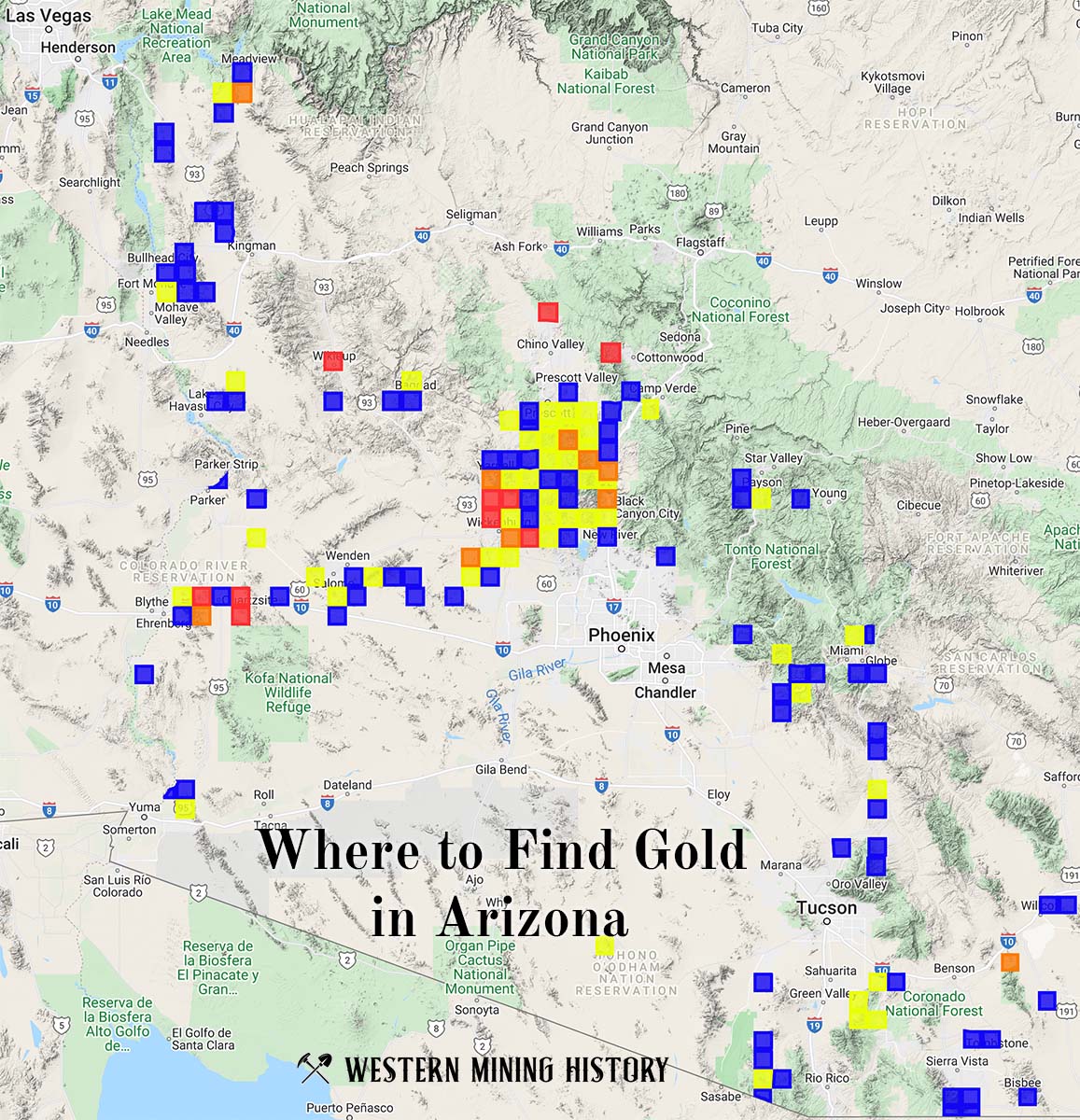The Orphan Lode Mine is a copper, silver, and uranium mine located in Coconino county, Arizona at an elevation of 6,959 feet.
About the MRDS Data:
All mine locations were obtained from the USGS Mineral Resources Data System. The locations and other information in this database have not been verified for accuracy. It should be assumed that all mines are on private property.
Mine Info
Elevation: 6,959 Feet (2,121 Meters)
Commodity: Copper, Silver, Uranium
Lat, Long: 36.07139, -112.15000
Map: View on Google Maps
Orphan Lode Mine MRDS details
Site Name
Primary: Orphan Lode Mine
Secondary: Orphan
Secondary: Orphan N.P.2004
Secondary: Golden Crown Mining Co.
Secondary: Western Gold and Uranium
Commodity
Primary: Copper
Primary: Silver
Primary: Uranium
Tertiary: Lead
Tertiary: Nickel
Tertiary: Zinc
Tertiary: Magnesite
Tertiary: Gold
Tertiary: Iron
Tertiary: Molybdenum
Tertiary: Antimony
Tertiary: Manganese
Tertiary: Cobalt
Location
State: Arizona
County: Coconino
District: Orphan District
Land Status
Land ownership: Private
Note: the land ownership field only identifies whether the area the mine is in is generally on public lands like Forest Service or BLM land, or if it is in an area that is generally private property. It does not definitively identify property status, nor does it indicate claim status or whether an area is open to prospecting. Always respect private property.
Holdings
Not available
Workings
Type: Underground
Ownership
Owner Name: Cotter Corp.
Home Office: Roswell, N.M.
Info Year: 1978
Years: 1967 -
Production
Not available
Deposit
Record Type: Site
Operation Category: Past Producer
Operation Type: Underground
Discovery Year: 1891
Years of Production:
Organization:
Significant: N
Deposit Size: L
Physiography
General Physiographic Area: Intermontane Plateaus
Physiographic Province: Colorado Plateaus
Physiographic Section: Grand Canyon Section
Mineral Deposit Model
Not available
Orebody
Form: PIPELIKE, DISSEMINATIONS AND STRINGERS ON PIPE'S PERIPHERY
Structure
Type: L
Description: Breccia Pipe Is A Collapse Breccia And Annular Rings
Alterations
Alteration Type: L
Alteration Text: Bleaching, Argillization And Carbonization Extend Into Sediments As Function Of Permeability
Rocks
Name: Shale
Role: Host
Age Type: Host Rock Unit
Age Young: Late Permian
Analytical Data
Analytical Data: 12.5% IN HIGH GRADE ZONE. HIGH GRADE ORE-SAMPLES AVERAGE 1.0% U308. MO <0.003% IN A WULFENITE SAMPLE.
Analytical Data: CHIP SAMPLES RAN 0.008-1.0%EU
Materials
Ore: Galena
Ore: Chalcocite
Ore: Uraninite
Ore: Torbernite
Ore: Tennantite
Gangue: Siderite
Gangue: Dolomite
Gangue: Aragonite
Gangue: Barite
Gangue: Calcite
Gangue: Plagioclase
Gangue: Gypsum
Gangue: Quartz
Comments
Comment (Deposit): PIPE INCREASES IN SIZE DOWNWARD FROM 175 TO 450 FT DIAMETER. PIPE ITSELF HAS MAXIMUM DIAMETER OF 380 FT BUT MINERALIZED ANNUAL RING EXTENDS TOTAL DIAMETER TO 500 FT.
Comment (Commodity): ALSO TRACES OF AG, TI, ZN.
Comment (Development): PRODUCED URANIUM, COPPER, AND SILVER THROUGHOUT THE 1960'S
Comment (Deposit): THIS REPORT REPRESENTS A MERGER OF ORIGINAL RECORD M001823 WITH RECORD W016025 OF JAN WILT IN MOLYBDENUM FILE; CONTACT PERSON T.G. THEODORE, USGS. THIS RECORD ALSO CONTAINS DATA FROM DUPLICATE RECORD D000312 OF R.U. KING WHICH HAS BEEN DELETED FROM MAIN MRDS. ; INFO.SRC : 1 PUB LIT; 2 UNPUB REPT
Comment (Workings): 70 FT ADIT BEFORE 1955, AERIAL TRAMWAY BUILT IN 1956, TUNNEL AND SHAFT TO 1500 FT LEVEL DROPPED IN 1960.
Comment (Production): BY APRIL 1969 ORPHAN LODE HAD PRODUCED $40 MILLION IN URANIUM. A MAJOR PRODUCER IN ARIZONA. AVERAGED 2,000 TONS/MONTH IN 1959.
References
Reference (Deposit): USBM CRIB PRINTOUT M001823 [ABWilson, USGS, 01-nov-2011: This is an original USGS MRDS number. It is not a USBM file, though it is possible that USBM supplied a printout to ADMR for them to compile MAS records. The orginal MRDS was called CRIB.]
Reference (Deposit): BUTLER,A.& BYERS,V., AZ.B.M.#180,P287
Reference (Deposit): HICKS,C., ADMR MOLY OCCURRENCES,MIN.RPT#3,P15
Reference (Deposit): ADLER,H2 ECON.GEO, VOL.58,NO6,P849-850
Reference (Deposit): ADMR ORPHAN MINE FILE
Reference (Deposit): BLM MINING DISTRICT SHEET 62
Reference (Deposit): US-AEC 172-479,P2,8,9
Reference (Deposit): USGS BRIGHT ANGEL QUAD
Reference (Deposit): KING,R., AZ.B.M.#180,P235
Reference (Deposit): ADMR U FILE
Reference (Other Database): CIMRI
Reference (Production): KEITH, 1970, P.262
Reference (Deposit): BOWLES, 1977, USGS CIRC. 753, P. 25-27.
Reference (Deposit): GORNITZ & KERR, 1970, COLUMBIA UNIV.
Reference (Deposit): KOFFORD, 1969, FOUR CORNERS GEOL. SOC. GUIDEBOOK, P. 190-194.
Reference (Reserve-Resource): KEITH, 1970, P. 262.
Reference (Deposit): KEITH, 1970, ARIZ. BUREAU OF MINES BULL. 182, P. 103-159, 202-289.
Reference (Deposit): GRANGER AND RAUP, R., 1962: U.S. GEOLOGICAL SURVEY BULLETIN 1147-A, p. A7-A12..
Pages: p. A7-A12
Arizona Gold

"Where to Find Gold in Arizona" looks at the density of modern placer mining claims along with historical gold mining locations and mining district descriptions to determine areas of high gold discovery potential in Arizona. Read more: Where to Find Gold in Arizona.